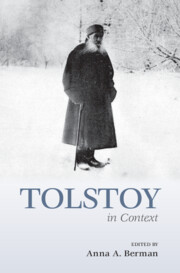Book contents
- Tolstoy in Context
- Tolstoy in Context
- Copyright page
- Contents
- Figures
- Notes on Contributors
- Preface
- Acknowledgments
- Note on Citations, Translations, and Transliterations
- Chronology
- Part I The Man
- Part II Russian Social and Political Contexts
- Chapter 5 Peasants and Folklore
- Chapter 6 The Great Reforms
- Chapter 7 Nobility and the Russian Class System
- Chapter 8 The Russian Orthodox Church
- Chapter 9 Law
- Chapter 10 Politics
- Chapter 11 War and the Military
- Chapter 12 Tolstoyans
- Chapter 13 Clothing
- Chapter 14 The “Woman Question”
- Chapter 15 The Family
- Part III Literature, the Arts, and Intellectual Life
- Part IV Science and Technology
- Part V Beyond Russia
- Part VI Tolstoy’s Afterlife
- Suggested Further Reading
- Index
Chapter 5 - Peasants and Folklore
from Part II - Russian Social and Political Contexts
Published online by Cambridge University Press: 05 January 2023
- Tolstoy in Context
- Tolstoy in Context
- Copyright page
- Contents
- Figures
- Notes on Contributors
- Preface
- Acknowledgments
- Note on Citations, Translations, and Transliterations
- Chronology
- Part I The Man
- Part II Russian Social and Political Contexts
- Chapter 5 Peasants and Folklore
- Chapter 6 The Great Reforms
- Chapter 7 Nobility and the Russian Class System
- Chapter 8 The Russian Orthodox Church
- Chapter 9 Law
- Chapter 10 Politics
- Chapter 11 War and the Military
- Chapter 12 Tolstoyans
- Chapter 13 Clothing
- Chapter 14 The “Woman Question”
- Chapter 15 The Family
- Part III Literature, the Arts, and Intellectual Life
- Part IV Science and Technology
- Part V Beyond Russia
- Part VI Tolstoy’s Afterlife
- Suggested Further Reading
- Index
Summary
Leo Tolstoy wrote throughout his career about Russian peasants, first at a class-inflected distance but later with admiration for their clothing, labor, and religious and moral feelings. As a Count, he automatically held a particular position vis-à-vis peasants, especially before the 1861 emancipation. His literary works and teaching tales depict peasants variously, sometimes idealizing an individual (from Platon Karataev in War and Peace to Alyosha the Pot), other times looking with distrust or frustration at peasant groups and their stubborn opposition to farming innovations. Eventually, Tolstoy famously adopted peasant garb, practiced many kinds of peasant crafts and labor, and enthusiastically communicated with peasant and sectarian thinkers, admiring their simple Christian faith. His primers for peasant children and collections of teaching tales often picked up folktales, paring their style down to the extreme simplicity that he considered typical and preferable. Toward the end of his life Tolstoy sought out the opinions and experiences of Russian peasant laborers in works of passionately engaged journalism. Major figures in Russian revolutionary movements (Lenin, Plekhanov) admired his insights, letting his authority in depicting peasant life continue into the Soviet period.
- Type
- Chapter
- Information
- Tolstoy in Context , pp. 39 - 46Publisher: Cambridge University PressPrint publication year: 2022

